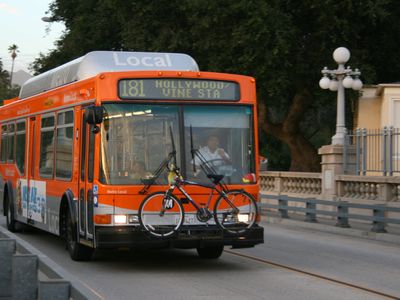
The number of passengers served by the agency fell in 2016, in spite of an uptick in train riders
Metro expanded its rail network in 2016, opening eagerly anticipated extensions of the Gold and Expo rail lines—but a surge in the number of people taking trains was not enough to overcome a sharp decline in bus ridership.
Bus ridership plunged nearly 9 percent, and systemwide, Metro tallied 25 million fewer rides last year than in 2015, a 6 percent drop, according to the Los Angeles Times.
As the Times reports, the decline in bus ridership is puzzling Metro officials, who offer a number of possible explanations. It’s possible, they say, that the drop in ridership is part of a nationwide trend that’s hit other cities, including New York.
Some riders may also be walking, biking, or using ridesharing apps such as Uber and Lyft more often, Conan Cheung tells the Times. Cheung, who is Metro’s executive officer for finance, also acknowledges that the bus system may need a major update—it’s been more than a decade since Metro gave its bus network a comprehensive overhaul.
Possibly as a result, Cheung says that the agency may be losing some of its core riders—those that rely on buses and trains as their primary mode of transportation. Such losses can have an outsize effect on Metro’s ridership data because such passengers generally take multiple trips per day.
After three years of relatively steady ridership numbers, the amount of people taking buses began declining in 2014—the same year that Metro raised prices for both buses and trains. Perhaps not so coincidentally, gas prices began falling nationwide around the same time.
As the Times suggests, a recent state law allowing undocumented immigrants to apply for driver’s licenses may have given some longtime riders the opportunity to drive instead. But the law went into effect in 2015, a year after ridership began to decline.
Regardless of the reasons, Metro has reason to be concerned about a dip in bus ridership. Though the city’s expanding network of train lines is drawing many new riders to the mass transit, buses still account for the lion’s share of the total number of miles covered by the system—and a great deal of Metro’s revenue.
A post on Metro’s blog, The Source, notes that the agency is taking steps to improve rider experience to draw more passengers. These include adding cars to light rail lines that are often crammed to capacity during peak hours.
The agency is also poised to rework its security arrangement, looping in local police departments as well as the Sheriff’s Department. As the Times points out, Metro surveys have shown that safety is one of the biggest issues preventing people from riding.
